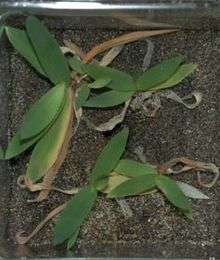Dichanthelium lanuginosum
| Dichanthelium lanuginosum | |
|---|---|
 | |
| Scientific classification | |
| Kingdom: | Plantae |
| (unranked): | Angiosperms |
| (unranked): | Monocots |
| (unranked): | Commelinids |
| Order: | Poales |
| Family: | Poaceae |
| Genus: | Dichanthelium |
| Species: | D. lanuginosum |
| Binomial name | |
| Dichanthelium lanuginosum (Ell.) Gould | |
Dichanthelium lanuginosum (Panic grass) is a species of grass. It is widespread in North America, and is most common in central and eastern United States. It is found in a variety of habitats, mostly in open, dry areas.[1]
A variety, D. lanuginosum var. thermale, grows in geothermal areas of Yellowstone National Park, United States. It is able to withstand high temperatures and high acidity in its rhizosphere.[2] In 2007 it was found that the heat tolerance is conferred to the grass by a symbiosis between a fungus and a virus. When it is colonised by the fungus Curvularia protuberata and the fungus is in turn colonised by a particular virus, the grass is able to tolerate soil temperatures of up to 65 °C that would otherwise be lethal.[3] Due to the distinctiveness and isolation of this taxon, it is sometimes considered to be a separate species: Dichanthelium thermale.[1]
References
- 1 2 Thomas, Justin (21 September 2015). "Revision of Dichanthelium sect. Lanuginosa (POACEAE)" (PDF). Phytoneuron. 2015 (50): 1–50. Retrieved 18 February 2016.
- ↑ Stout, R. G.; Stout R. G.; Summers M. L.; Kerstetter T.; McDermott T. R. (1997). "Heat- and acid-tolerance of a grass commonly found in geothermal areas within Yellowstone National Park". Plant science. 130 (1): 1–9. ISSN 0168-9452. doi:10.1016/S0168-9452(97)00205-7.
- ↑ Márquez, Luis; Regina Redman; Russell Rodriguez; Marilyn J. Roossinck (2007). "A Virus in a Fungus in a Plant: Three-Way Symbiosis Required for Thermal Tolerance" (PDF). Science. 315 (5811): 513–5. PMID 17255511. doi:10.1126/science.1136237.